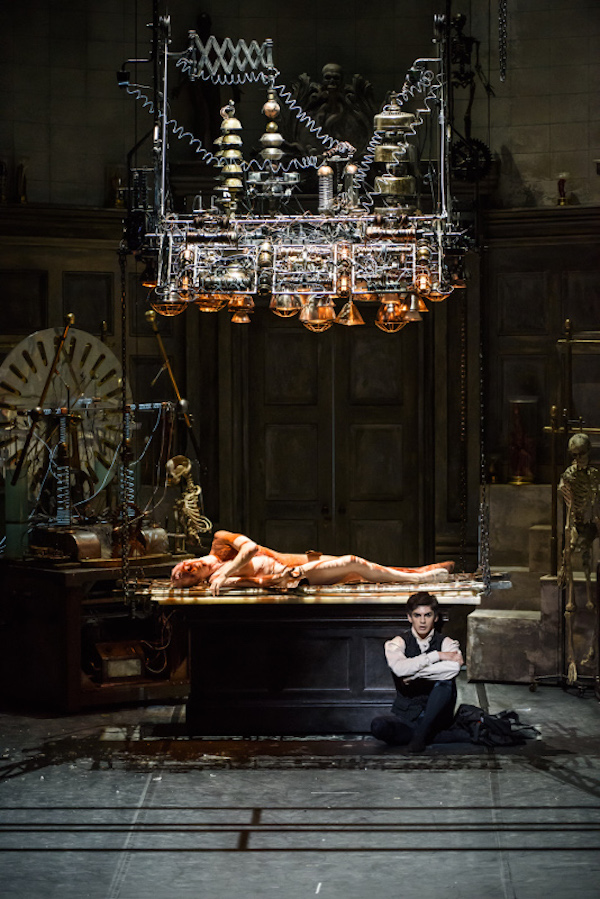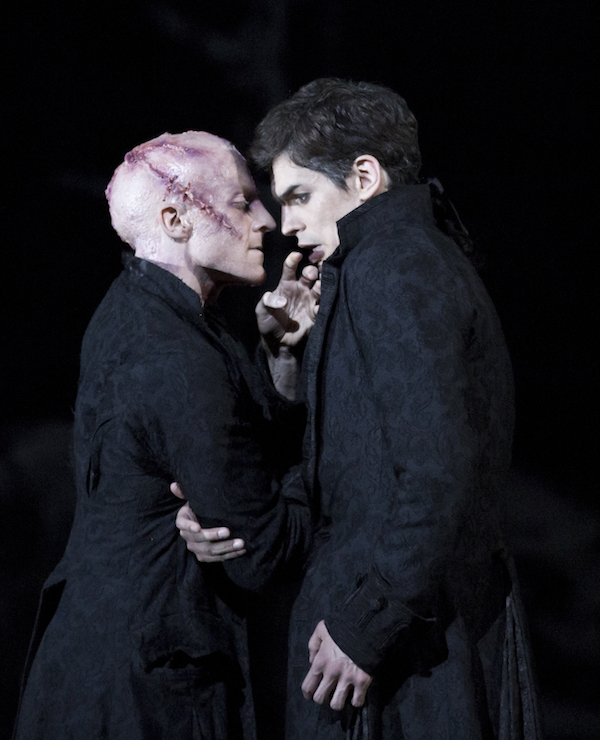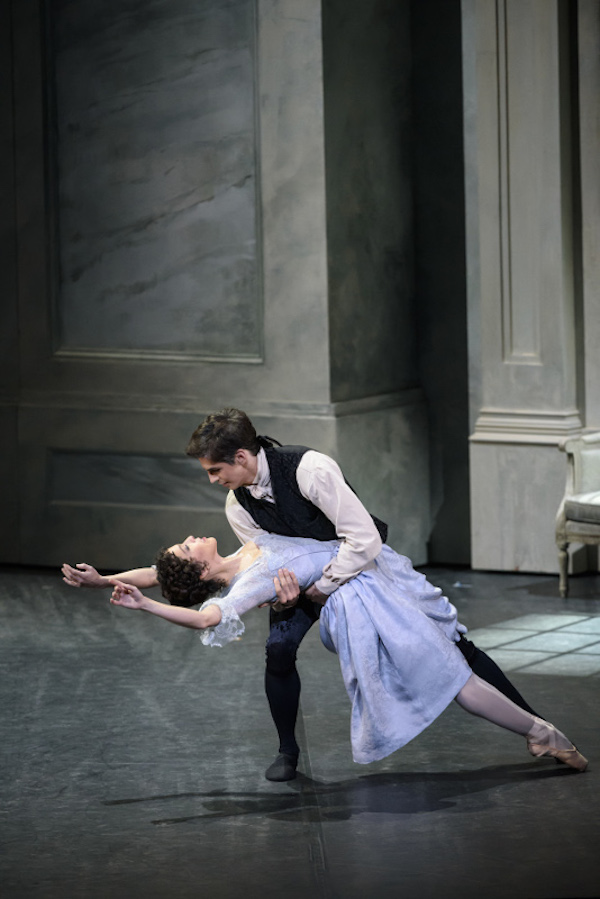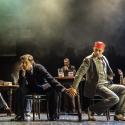Another year, another new full-length story ballet from one of the Royal Ballet's in-house choreographers. Time was – a long time, in fact, up to 2011 – when that would have sounded like science fiction, but no longer: Liam Scarlett, whose Frankenstein premiered last night at the Opera House, is treading a path worn smooth in the past five years by Christopher Wheeldon, Wayne McGregor and Carlos Acosta.
All have played to type in some respects: Wheeldon with pretty, fantasy spectacles (The Winter's Tale, Alice), Acosta with hispanophone classics (Carmen, Don Quixote), and McGregor with the thoughtful but over-produced Woolf Works, and all the advance information about Frankenstein suggested it too would build on Scarlett's previous form. The young choreographer has already conjured shadowy killers (in Sweet Violets) and disturbed families (in Hansel and Gretel); he has worked with composer Lowell Lieberman (on Viscera) and frequently with designer John Macfarlane, while pieces like Asphodel Meadows and Hummingbird have proven him a dance-maker of both substance and freshness. With Mary Shelley's novel as source material, a thriller that also crackles with questions about creation, power, responsibility, family, the limits of science and the essence of humanity, I thought Scarlett might make something seriously good.
 Perhaps too much was expected of him. The Frankenstein ballet presented last night had several moments of high drama and a couple of stunning sets by Macfarlane, but the material was stretched so thin over the space it had to fill that it had actually ripped at the seams, leaving gaping holes that even typically lavish ROH production values hadn't a hope of patching over.
Perhaps too much was expected of him. The Frankenstein ballet presented last night had several moments of high drama and a couple of stunning sets by Macfarlane, but the material was stretched so thin over the space it had to fill that it had actually ripped at the seams, leaving gaping holes that even typically lavish ROH production values hadn't a hope of patching over.
Chief among them was the problem of Frankenstein himself (Federico Bonelli, pictured above right), the complicated creator who evades responsibility for his creation. In the novel, first-person narration gradually reveals his ego and unreliability, but on stage and in the medium of dance he's just a cipher, an empty space at the heart of the ballet. Despite the laboured staging in Act I of his family backstory – the adopted sister/love interest, the mother who died in childbirth, the housekeeper who is strangely nasty to her own daughter – Frankenstein's subsequent brooding arrogance feels like a plot device rather than a character trait. In fact, he reminded me strongly of the similarly black-clad Onegin in John Cranko's ballet of that name, even to the extent of frowning over books instead of joining in with fun.
When “fun” consists of hanging out with that ballet cliché, a bunch of cheerful whores, though, I don't blame him for not being keen. Besides the fact that the Royal Ballet's female corps members must be tired of getting their wigs on and their knickers out, the tavern-with-prostitutes scene is an unnecessary and therefore inexcusable interruption to the genuinely odd and thrilling business of the anatomy theatre, the ballet's strongest scene.
 Of course using the corps (immortally described by Dada Masilo as “surplus girls in the moonlight”) is a ballet convention, but Frankenstein's downfall is that if feels so damn conventional; there's not a flicker of life or character in the troops of servants, whores and party guests who cross the stage looking like refugees from some other ballet. (In the last act, which starts with a ball to celebrate Frankenstein's wedding, Lieberman's score – at one of the few moments it was characterful enough to notice – pays audible homage to Prokofiev's Cinderella, while the corps have to almost visibly restrain themselves from making Sleeping Beauty-style obeisances to the couple, dressed in prince-and-princess white.)
Of course using the corps (immortally described by Dada Masilo as “surplus girls in the moonlight”) is a ballet convention, but Frankenstein's downfall is that if feels so damn conventional; there's not a flicker of life or character in the troops of servants, whores and party guests who cross the stage looking like refugees from some other ballet. (In the last act, which starts with a ball to celebrate Frankenstein's wedding, Lieberman's score – at one of the few moments it was characterful enough to notice – pays audible homage to Prokofiev's Cinderella, while the corps have to almost visibly restrain themselves from making Sleeping Beauty-style obeisances to the couple, dressed in prince-and-princess white.)
Steven McRae as the strange and troubled Creature is better than Bonelli's Frankenstein, though a movement language of cowering, alienation and longing is still too limited for a character who in the novel is an articulate observer of human society. But at least his occasional threatening presence reminds us this isn't A Month in the Country, and the charged, angry, homoerotic pas de deux in which Frankenstein and the Creature finally confront each other (pictured above left) is the most powerful piece of dance in the evening. It's as if two leads, which have been kept apart for the whole ballet, are finally connected to the same battery: the current suddenly flows. But, just as quickly, it dies again, leaving the ballet to peter out in a wan sort of Götterdämmerung, in which the flames consuming all the sorry protagonists' corpses are suggested by gentle tinkling in the score and the only oomph comes from the volcanic-red lighting of Macfarlane's superb Turner-ish backcloth (main picture), surely a contender for one of the loveliest ever painted.
 After all the firecrackers during the earlier creation scene, I'd half hoped we might get a full-stage immolation like in David Greig's Bacchae for the National Theatre of Scotland, but this Frankenstein's calling card is being overdone when it should be underdone, and vice versa. The flash-bang steampunk kit deployed for the creation is wholly at odds with both Macfarlane's faithfully recreated 18th-century anatomy theatre, and with the novel's infinitely creepier picture of a sudden, silent, late-night awakening. The meaty themes of parental neglect, familial rejection and cruelty are jostled for space by pointless corps de ballet dances. There are lots of duets for Bonelli and Laura Morera (as love interest Elizabeth, pictured above right) but there's nowhere for these one-dimensional characters to go in them, while fabulous actors Bennet Gartside and Elizabeth McGorian are sadly underused. The final scene sees the corps women in absurdly OTT sequinned dresses, yet all evening the male dancers have been in black stockings and shoes which obscure their feet. The list could go on.
After all the firecrackers during the earlier creation scene, I'd half hoped we might get a full-stage immolation like in David Greig's Bacchae for the National Theatre of Scotland, but this Frankenstein's calling card is being overdone when it should be underdone, and vice versa. The flash-bang steampunk kit deployed for the creation is wholly at odds with both Macfarlane's faithfully recreated 18th-century anatomy theatre, and with the novel's infinitely creepier picture of a sudden, silent, late-night awakening. The meaty themes of parental neglect, familial rejection and cruelty are jostled for space by pointless corps de ballet dances. There are lots of duets for Bonelli and Laura Morera (as love interest Elizabeth, pictured above right) but there's nowhere for these one-dimensional characters to go in them, while fabulous actors Bennet Gartside and Elizabeth McGorian are sadly underused. The final scene sees the corps women in absurdly OTT sequinned dresses, yet all evening the male dancers have been in black stockings and shoes which obscure their feet. The list could go on.
That Frankenstein came to the public in this unsuitable form is a sad waste of money, and suggests management issues: a young choreographer, however talented, shouldn't be working alone on his first big story ballet, and alarm bells must have rung at the ROH when, as is rumoured, principals Vadim Muntagirov and Marianela Nuñez refused to dance. If the spend is to be recuperated and the ballet kept for the repertory, there needs to be some rigorous cutting (it should be a two-acter, tops) and a much tighter focus on the strange symbiotic relationship of creator and creation. Otherwise, I'm afraid it will go the way of its ill-fated title character and his unloved Creature.
- The Royal Ballet perform Frankenstein at the Royal Opera House until 27 May. There is a live cinema relay on Wednesday 18 May















Add comment